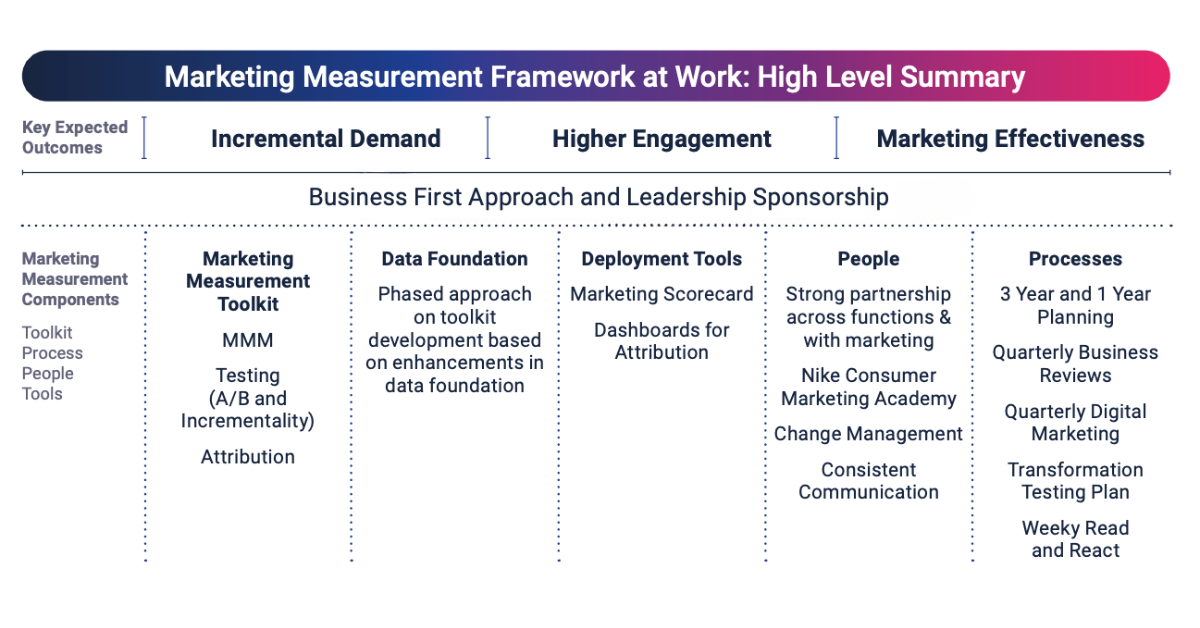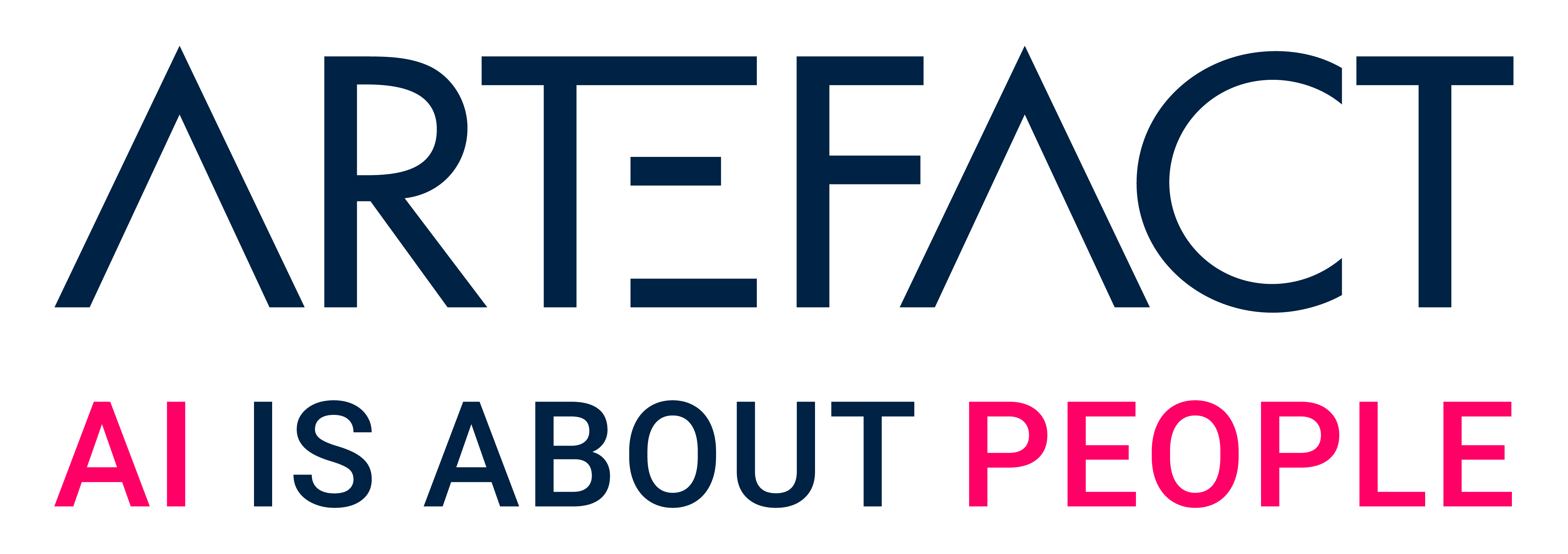Nike’s journey in operationalising marketing measurement is a story of ongoing learning, persistence and transformation. It wasn’t an easy path — change took time, and the process required consistent effort, experimentation, and a willingness to adapt.
Below is a summary of what I believe are the key transferable learnings on marketing measurements across other companies and industries.
1. A business-first mindset: Leadership, Integration, and Prioritization
At the heart of Nike’s success is a business-first mindset, where marketing measurement is treated as a strategic enabler of enterprise-wide goals. This approach was championed by senior leadership and deeply integrated into the company’s broader business operations, including digital commerce and general management.
One of the most significant cultural shifts at Nike was the adoption of incrementality measurement to assess the true impact of marketing. By focusing on incremental outcomes—such as new customer acquisition, increased engagement, and additional revenue—Nike moved beyond surface-level metrics to demonstrate the tangible value of its marketing investments.
The marketing team played a central role in this transformation, setting priorities and defining the key questions for tools like MMM, attribution, and incrementality testing. Marketing Science, as the functional experts, provided recommendations on how to address these questions, crafted actionable insights, and suggested the phasing of tool deployment based on feasibility and data readiness. This collaborative approach ensured that measurement efforts were strategic, effective and actionable.
Consistency was another critical factor in Nike’s success. For example, the company used the same marketing scorecard every quarter, even when all the data wasn’t available. Missing data points were marked as “N/A” and filled in as they became available. This disciplined approach helped build trust in the process and ensured that measurement became a regular part of business operations rather than a one-off exercise.
2. Marketing Measurement toolkit: Evolving to meet complexity
Nike’s marketing measurement framework is built on a toolkit designed to address both strategic and operational needs. However, this wasn’t achieved overnight. Initially, Nike used an out-of-the-box MMM tool from a vendor, but it quickly became clear that the tool couldn’t fully address the complexity of Nike’s business. Deployment was limited, and the insights were not actionable enough to drive meaningful change.
As Nike’s maturity in marketing measurement increased—and with strong senior leadership sponsorship—the company decided to in-house its MMM capabilities. This allowed Nike to tailor the tool to its unique business needs, increase granularity, and better align with its strategic priorities.
Today, Nike employs a mix of methodologies, including MMM, attribution, and incrementality testing, to provide a comprehensive view of marketing effectiveness. MMM serves as the cornerstone for long-term planning, offering insights into the incremental impact of marketing investments across channels and geographies. Attribution and incrementality testing complement this by enabling more granular, real-time optimization of campaigns. Together, these tools create a holistic measurement ecosystem that balances short-term agility with long-term strategy.
Nike’s phased approach to deploying these tools has been critical to its success. By focusing first on areas with the strongest data foundations and highest potential ROI, Nike was able to demonstrate quick wins, build internal confidence, and scale its measurement capabilities over time. This pragmatic approach ensures that tools are not just implemented but are actively driving business impact.
3. Process: Embedding measurement into the business
One of Nike’s most significant achievements has been the integration of marketing measurement into existing enterprise and marketing processes. Measurement is not treated as an isolated function but as a core component of how the business operates.
MMM insights are embedded into annual and quarterly planning cycles, aligning marketing investments with broader business goals. Attribution data is used in weekly business processes to enable in-season adjustments, while A/B testing is systematically incorporated into digital marketing transformation initiatives through a ‘testing pods’ offense.
This integration extends beyond marketing to other parts of the business, such as digital commerce and general management. By wiring measurement into these processes, Nike ensures that marketing insights are not just theoretical but are directly influencing business outcomes.
4. People: Building a culture of data-driven decision-making
Nike’s journey in marketing measurement required not just tools and processes but also a significant investment in people. The company recognized early on that tools alone wouldn’t drive change—building a culture of data-driven decision-making was essential.
The Nike Consumer Marketing Academy played a central role in this effort, driving data literacy and digital acumen across the organization, from junior marketers to senior executives.
Change management was equally critical. The shift to a measurement-driven culture took time and required consistent education, communication, and leadership buy-in. By securing sponsorship from senior leaders and demonstrating the value of measurement through incremental wins, Nike was able to build momentum and foster a mindset where measurement became a strategic asset.
5. Tools for democratizing insights
To make measurement insights accessible and actionable, Nike developed a suite of tools that democratize data across the organization. Static scorecards provide a high-level view of key performance indicators (KPIs) for global and regional teams, and are used for Quarterly Business Reviews, while dashboards enable quicker reading on trends from attribution.
Looking at how other companies implemented marketing measurement, Nike had opportunities to increase data democratization by expanding its suite of self served dashboards or even using generative AI to further enhance accessibility.
The vision is to empower marketing teams to ask natural language questions and receive actionable insights directly from MMM and other measurement tools. This innovation has the potential to significantly reduce the time-to-insight, increase efficiencies and enable more agile decision-making.
6. Learnings along the way
Nike’s journey in marketing measurement revealed several key insights that reshaped its approach to marketing. Some examples are summarized below:
- MMM insights: While marketing drove significant incrementality, inefficiencies emerged in the funnel. Paid marketing drove significant new member sign-ups, but there was an opportunity to increase the quality of these new members, as many of them never made a purchase. Nike also found that Paid media was being used from top to bottom of the funnel, while the company could have better leveraged its rich first-party data to drive loyalty and bottom-funnel conversions through owned media.
- Incrementality testing: These MMM findings led Nike to test different customer journeys to drive first and second purchases and maintain loyalty. A/B testing helped refine these pathways, such as the onboarding journey, improving conversion rates and customer retention.
- Attribution insights: Attribution analysis confirmed that triggered, more targeted communications significantly outperformed broad-based campaigns and helped the change management process to shift to a ‘fewer and better’ communication strategy.
Conclusion
Nike’s journey in marketing measurement demonstrates that success is not about having the “best” tool—it’s about having the most appropriate tool for your organization’s use cases and maturity. Tools alone won’t drive the highest ROI. The true value of marketing measurement lies in how well it is wired into company processes, supported by strong leadership sponsorship, and embraced through effective change management.
This was not an easy journey for Nike. Change took time, and consistency was key. By sticking to a disciplined approach, Nike built trust in the process and created a foundation for long-term success.

 BLOG
BLOG





